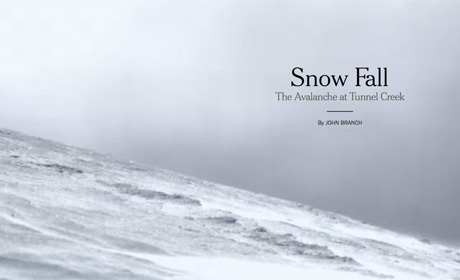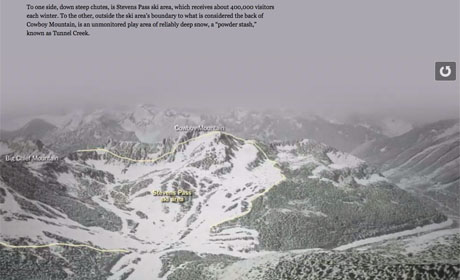
When it comes to innovative, beautiful, long-form digital storytelling, there is one project in particular which is likely to spring to mind for many in the journalism world, and that is Snow Fall: The Avalanche at Tunnel Creek.
The New York Times digital feature has already won a number of awards, with author John Branch, a sports reporter at the New York Times, recently receiving a Pulitzer prize for his work.
Following his win, Branch spoke to Journalism.co.uk about how his story came to receive the digital delivery it did, the process behind-the-scenes, some of the interesting discussions it prompted within the New York Times about how best to treat such works, and why it has struck such a chord with audiences and the journalism industry alike.
From the beginning
When Branch first started out in the research stages of the story, there was "no great ambition in terms of multimedia", he said. For Branch, it was like any other story.
"I went out and reported it and at some point I think mostly to prove to my bosses that I was actually working, I sent them a giant file of interviews with some of the people who had survived the avalanche.
Upon receiving this material they "made the pretty rare step" of giving other departments within the news outlet, such as photography, graphics, multimedia and video teams, a look at what he had found so far, with the intention of seeing if they wanted "to do more than just the usual".I certainly had no imagination for what it would become - apparently a couple of others had more imagination than I didJohn Branch
"They all took a look at the information that was passed on to them and said 'yeah, we're in'," Branch said.
"I don't know exactly what it was that struck their fancy, but they all decided 'yes we want to be all in', and that's where the whole thing really started to get rolling in terms of a presentation."
At this stage there was still no real idea that they would end up with the product that they ultimately did.
"I've written a million stories that have had a photographer pretty much embedded with me and maybe a video journalist embedded with me," Branch said. "That's kind of where it ends, is the photographer and the video journalist."
He continued: "We might ask graphics to chime in and help us out with a few graphics but in this case I really think some of those editors in those departments thought there was a possibility to do something more.
"So it was not going to be just a typical New York Times story with those elements, text, video and photo, they somehow visualised a large-scale project."
"I certainly had no imagination for what it would become," he added. "Apparently a couple of others had more imagination than I did."
In total, from start to finish, the project took six months. It was a busy time for the newsroom, with the timing coinciding with presidential elections and the London Olympics, as well as Hurricane Sandy hitting New York.
"So there were a lot of things that took priority over this, and that might have been one of the reasons why people saw this as a chance to do something fully as a presentation; because there was no real time element to it.
"We could really run it whenever we were ready and so it became not the priority for a long time."
The power of the visuals

Branch said that he was asked by some whether he was concerned "that the presentation itself would overwhelm your words", but that this was far from the case.
"They helped tell the story. I think writing 17,000 words, I can use all the help I can get in terms of having graphics and photos and videos help keep the reader going, so I'm very grateful for that.
"And I think they helped inform the story. I think being able to see that fly-over video of the mountain itself was hugely informative.
"As much as I like to think I can explain things very well, it's not at all like being able to actually see it."
And, he added, the immersive presentation only helps in terms of bringing new readers to the story.
"I'm glad if people came to it who would not have otherwise read the story, people who might have an interest in this kind of digital journalism, or digital storytelling, and that got them to the story, that's fantastic," he said.
"I don't think we really care necessarily what it is that gets people reading, we just want people to engage with it and that's what happened here."
While the presentation was different to the average article, Branch said editorial strongly protected the text element of the story, and that he did not think it "changed things" in terms of his writing of the story.
"There were discussions early on about whether or not this would have to be written differently or whether or not there might have to be some changes in the way certain parts of it are written," he said, such as whether a graphic or piece of audio might replace the words telling that part of the story.
"In [the sports editor's] world the text itself, the story, the words themselves, were the key ingredient and he was fine with anyone wrapping the presentation around it. I think he was a little more nervous about trying to wrap the presentation through it and somehow damaging or altering or changing the text.
"I'm glad we were able to keep the text intact. Certainly all the multimedia elements aided the text and helped the reader but we didn't throw away some of the text because we have the multimedia."
But, he added, "it was an interesting conversation to have".
"I'm sure we've probably had it since then and I'm sure a lot of newsrooms will continue to have these conversations about whether or not we change the way we write stories to make room for or in light of the multimedia that's part of the storytelling."
Inspiring others
While not every news outlet may be in the position to produce a Snow Fall, the New York Times and other examples of long-form multimedia storytelling have served to demonstrate the demand. And Branch hopes it "spurs people into increasing their ambitions for these kinds of projects".
"I think we've underestimated the power of readers and especially when you do a long-form piece like this and put it in such a presentation, I think we proved that there is an appetite for this, maybe we have been underestimating readers all along."I think we proved that there is an appetite for this, maybe we have been underestimating readers all alongJohn Branch
He added that developments in technology are likely to continue moving the markers in terms of what is possible for smaller news outlets.
"While I realise that a lot of papers can't do this now, they don't have teams of graphic artists the way we do, I don't know where technology's going to go with this.
"Some of those graphics, for example, which might have taken one of our artists several weeks to do, I would not be surprised at all if in three or four or five years it's something somebody can do in one shift, in a few hours.
"Technology is changing so so fast that it's hard to imagine but I think we'll look back at Snow Fall and people will say, 'oh yeah, that was quaint, that was cute back there in 2012/2013', but we know that's the case.
"We'll look back it and by a few years from now we'll have blown past it in terms of the technology and in terms of how we wow people, and so I think the technology will catch up and will allow smaller newsrooms to do this kind of thing, probably faster than we know."
What lies ahead at the New York Times
For the New York Times, the discussion today is about "how much video and multimedia is part of our future", Branch said.
The importance of video to the Times was signalled just last month when the news outlet decided to place its video outside its metered paywall. Executive vice-president of digital products and services group Denise Warren told Journalism.co.uk at the time that the newspaper wants its website to be seen "as not only a place to read about important stories of the day and interesting topics, but also a place to watch".I think the technology will catch up and will allow smaller newsrooms to do this kind of thing, probably faster than we knowJohn Branch
According to Warren the New York Times has seen a "very dramatic jump" in views of online video in the past year, only confirming "an appetite for this from our users".
Branch added that "one of the places that we're growing is in video".
"We are investing more money into our video productions, and that is not just simply video productions of documentary-style news features, but also how it gets integrated into our stories."
But he added, as video production grows, this presents an interesting question.
"At what point do you become not so much text, or not enough text, or too much text or whatever else. Where's that balance? I don't think we've figured it out yet, but I think we're realising we want to experiment with it."
- Hear more from Branch on immersive long-form storytelling in this Journalism.co.uk podcast
Free daily newsletter
If you like our news and feature articles, you can sign up to receive our free daily (Mon-Fri) email newsletter (mobile friendly).
Related articles
- Axel Springer CEO on OpenAI deal: 'We must protect intellectual property of news content'
- Audiences, AI and audio apps: five talking points from Perugia
- From Reuters to The New York Times, Big Oil pays 'most trusted media brands' to push greenwashing
- 38 mojo apps from BBC trainer Marc Blank-Settle
- Four digital media trends to watch: generative AI, Gen Z, business models and news formats









